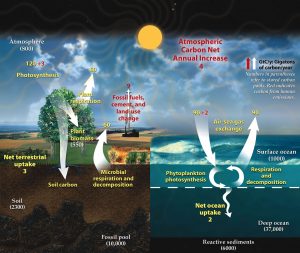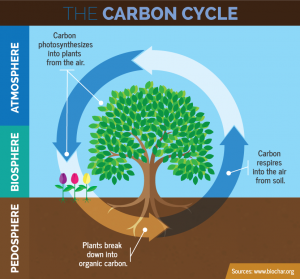Permafrost Carbon Cycle
The permafrost carbon cycle (also known as the Arctic carbon cycle) is the transfer of carbon from permafrost soils to vegetation and microbes, then to atmosphere, then back to vegetation, and finally back to permafrost soils. The Permafrost Carbon Cycle is a sub-cycle of the larger global carbon cycle.
Carbon-based molecules are crucial for life on Earth, because it is the main component of many biological compounds. In Earth’s atmosphere it exists either as carbon dioxide (CO2) or as methane (CH4).
Carbon dioxide leaves the atmosphere by becoming parts of plants through photosynthesis, through precipitation and by other means. Eventually plants and animals die and the carbon returns to the soil. Some organic carbon stays in the soil, while some is released back into the atmosphere through soil respiration.
Permafrost soils remain frozen for long periods of time, and therefore store large amounts of frozen organic carbon, including the carbon that is thousands of years old. Scientists still don’t know the exact amount of carbon contained in all the world’s permafrost, but approximately 1670 billion tons of carbon is stored in the permafrost ecosystems in high latitudes – twice as much carbon as is currently contained in the atmosphere.
As permafrost thaws due to the global warming, the frozen organic matter inside it thaws out, too, and begins to decay. Microbes in the soil eat the matter and produce big amounts of CO2 or CH4, which bubbles up through soil and water and back into the atmosphere.
The amount of carbon dioxide and methane being released from permafrost is increasing each year. There is also a possibility that some of the oldest carbon, which has been stored in permafrost soils for millennia, will be exposed, too. As carbon dioxide and methane accumulate in the atmosphere, these greenhouse gasses can accelerate global warming, and may also lead to methane eruptions.
According to the recent study, by the year 2050, the planet could see 55 billion tons of carbon (which converts to 200 billion tons of carbon dioxide) released from soils.
- The carbon cycle: © Bvelski
- The carbon cycle biosphere © Biochar




 This project (EDU-ARCTIC) has received funding from the European Union’s Horizon 2020 research and innovation programme under grant agreement No 710240. The content of the website is the sole responsibility of the Consortium and it does not represent the opinion of the European Commission, and the Commission is not responsible for any use that might be made of information contained.
This project (EDU-ARCTIC) has received funding from the European Union’s Horizon 2020 research and innovation programme under grant agreement No 710240. The content of the website is the sole responsibility of the Consortium and it does not represent the opinion of the European Commission, and the Commission is not responsible for any use that might be made of information contained.